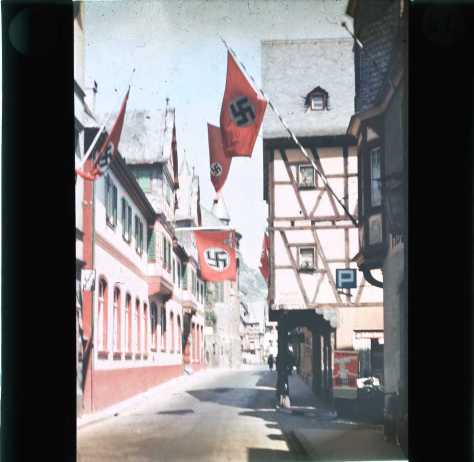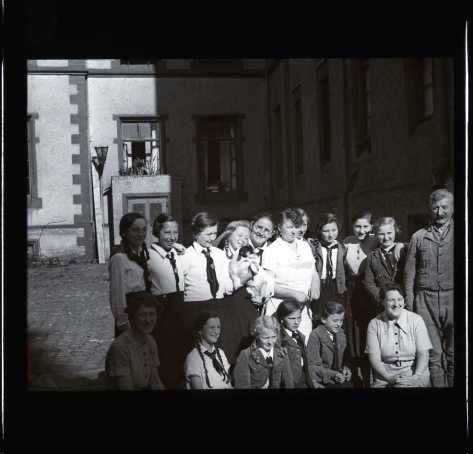Working with archives, I get to see so many snippets of history. Whether I pull out the wrong box, glance at the documents on the scanner or see the items being requested, I am continually exposed to a variety of archive material. Amongst those that I have come across, a few items from the Cycle’s Touring Club collection are particularly notable. The CTC collection has an abundance of photographs that capture moments from all over the globe…
The following glass lantern slides show a street in the Rhineland (circa 1936):
What stands out most for me is the casual nature of these photographs. They are mixed in with other shots of scenery and small towns. It was obvious that this was a typical view to behold, which it no doubt was.
This brings me to The Book Thief, a WWII film based on the Markus Zusak novel of the same name. This film tells the story of Liesel, a young girl growing up in Nazi Germany. The sets in this film are incredibly similar to the streets we see in the photos above.
The film was criticised by critics for underplaying Nazi Germany and for being too sentimental. Peter Bradshaw (The Guardian) called the film ‘strange and saccharine’ and Robbie Collin (The Telegraph) wrote, ‘life under the Third Reich’s iron grip looks more or less like a John Lewis Christmas advert’. Critics argued that it did not give enough over to the brutality of war; the deaths were spun into a peaceful, sorrowful scene; the key focus remained upon Liesel and her perception of the world around her.
However, for me, I think it is the focus on Liesel that makes this film so special and so accurate. The presence of the Nazi Party in Europe was a gradual change rather than a sudden occurrence. People had little choice but to accept the Nazi Party and the party became intrinsic to life at the time. The Book Thief weaves Nazi Germany into all corners of its setting: the visible dominance is integrated into everyday life.
Petronella, a famous female cycle tourist, recorded the details of her travels. Her lecture notes on her trip through the Rhineland in the late 1930s, provide a further insight into the attitudes towards the Nazi Party:
‘At Koblentz, Hitler was reviewing his troops, but we didn’t stop to make his acquaintance. We had a look at the German corner and at the bridge of boats. It was rather fascinating to watch the boats which form the bridge being moved to let one of the big Rhine boats come by. All the streets along the Rhine were decked with flags, possibly because of Hitler’s visit. We were charmed with Rhens and its lovely town hall.’
‘At the Youth Hostel at Boppard we had the best night’s sleep we had had since leaving home. Some of Hitler’s Storm Mädchen met us in the yard and helped to carry our bags up to our dormitory. They were funny little things in their short skirts and white blouses, and they were very interested in us. We could not understand each other very well but we managed to carry on a conversation of sorts. The next morning we took a photograph of them in the yard and they were so thrilled about it that they came to the door of our dormitory and serenaded us while we were packing. They sang song after song, until we began to think they would never finish.’
These comments give the same impression of Nazi dominance as does The Book Thief: it was both oppressive and pedestrian, becoming part of everyday life through constant presence and propaganda in a process that left people little choice but to comply. What is particularly interesting about The Book Thief is that it focuses on the small details rather than the big picture (with which we’re all familiar), examining how the rise of the Nazi party affected individual relationships. In my view, this is not the same as sentimentality.
Let us look then at the importance of archives for film. When we look at the CTC photos, I’m sure that those of you that have seen The Book Thief would agree: the similarities are uncanny. I found that there was distinct attention to detail when dealing with Nazi Germany in The Book Thief, from the scenery to the costume. It is obvious that the production team did their research. Many films depend on archive material to create an accurate historical backdrop, since these can be the only surviving records of the details of life in previous times. Whether it’s to create a replica costume or to design scenery, careful research is required to make the film as authentic as possible. It is very possible that photographs of streets like the ones from our archives led to the set design and costumes that you see in The Book Thief.
We often don’t realise the importance or relevance of archives to our lives. Yet they are fundamental in forming our perceptions of the past, be it through film, television or books. From surviving evidence, ranging from diary entries to photographs, we are able to build up a picture of life in a different time period. Archives also lend insight into people’s private life and character. No doubt archives were also fundamental in helping form Dickens’ character in The Invisible Woman, uncovering how Selfridges functioned as a business and understanding attitudes towards slavery in 12 Years A Slave. We all learn from archives, often without realising.






I have just finished reading the Book Thief though I haven’t seen the film! I found it very moving ; especially Leisel’s amazing courage and resilience through all she suffered. The book ended rather abruptly and left a lot unresolved! I would have liked to find out more about what happened to her! Xx
I loved the book too. I was rather hesitant to watch the film in case it ruined the book for me but I think it did a good job. Here’s a link to Markus Zusak’s blog where he talks about what happens after it ends: http://zusakbooks.tumblr.com/post/45944163316/liesel-and-max-do-they-remain-together
I think it’s quite nice that you get to decide!